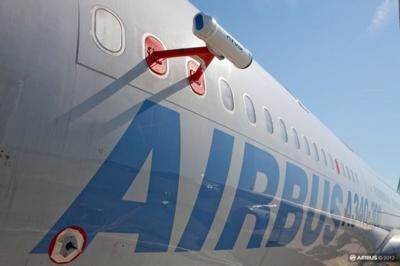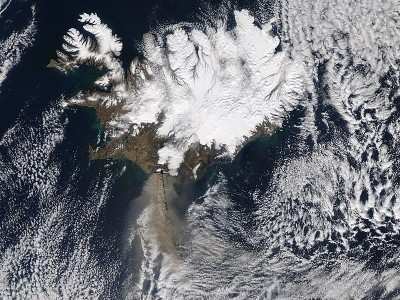Create 1st Ever Significant Artificial Ash Cloud For Test Purposes
UK budget carrier easyJet, along with its partners Airbus and Nicarnica Aviation, has successfully completed the final stage of testing for the AVOID volcanic ash technology through a unique experiment involving the creation of an artificial ash cloud.

An A400M Airbus test plane dispersed one metric ton of Icelandic ash into the atmosphere at between 9,000ft and 11,000ft thereby creating conditions consistent with the 2010 eruption. A second Airbus test aircraft, an A340-300, with the AVOID technology fitted, flew towards the ash cloud identifying and measuring it from around 60km away. The experiment also used a small aircraft, a Diamond DA42 from Duesseldorf University of Applied Sciences, to fly into the ash cloud to take measurements which help to corroborate the measurements made by the AVOID system.
The ash cloud produced during the test was between 600ft and 800ft deep measuring 2.8km in diameter. To be begin with the ash cloud was visible to the naked eye but dissipated quickly becoming difficult to identify. The AVOID volcanic sensor detected the ash cloud and measured its density which ranged from 0.1 to 1 g m-2 – or concentrations of 100 to 1000 µg m-3. This is within the range of concentrations measured during the Eyjafjallajokul ash crisis in April and May 2010.
"The threat from Icelandic volcanoes continues and so we are delighted with the outcome of this unique and innovative experiment. Finding a solution is as crucial now as ever to ensure we never again see the scenes of spring 2010 when all flying ceased across Europe for several days," said Ian Davies, easyJet's Engineering Director. "This is a key step in the final journey of testing the technology and moving towards commercial certification. easyJet will now work towards a non-integrated stand-alone system which we aim to fit onto a number of our current fleet of aircraft by the end of 2014."
"The team has just executed a unique scientific and engineering experiment conclusively demonstrating that low concentrations of ash can be identified by the AVOID sensor," said Dr Fred Prata, inventor of the AVOID technology. "The highly successful outcome of this complex experiment which involved delivering 1000 kg of fine ash into a small airspace, controlling four aircraft and coordinating the measurements from two of the aircraft, is a testament to the commitment and skills of easyJet and AIRBUS engineers and a great example of industry and science coming together to solve an important problem."

“Airbus ... has supported and performed many test programs both independently and also in collaboration with other organizations," said Charles Champion, Airbus’ Executive Vice President, Head of Engineering. "Today with AVOID we wanted to prove in the project that the ash-detection concept can work and this has been demonstrated in the test. Now we need to analyses all data gathered. We are at the beginning of an invention which could become a useful solution for commercial aviation to prevent large-scale disruption from volcanic ash.”
The risk of another Icelandic eruption remains high as Magnús Tumi Gudmundsson from the Institute of Earth Sciences in Iceland, explained. “Explosive volcanic eruptions in Iceland happen on average once every five years," he said. "When winds blow from the northwest, the ash is transported towards Europe as it did during the Eyjafjallajökull eruption in 2010. It was a coincidence that this did not happen in the seven explosive eruptions that took place between 1970 and 2010, instead the ash was mostly carried away from Europe by southerly winds.
“Considering the relatively long time since the last eruptions in two of Iceland‘s most active volcanoes, Hekla and Katla, both should be regarded as ready to erupt. It is not possible to predict when or where the next eruption will take place. What is certain is that it will happen.”
Between 15 and 21 April 2010 Europe experienced an unprecedented closure of airspace. During this time 80% less flights operated with more than 100,000 flights cancelled in total. The gross losses of the global aviation industry was an estimated $2.6bn as a result of the air space closures.
The ash used in the test was from the 2010 Eyjafjallajokul eruption. It was collected and dried by the Institute of Earth Sciences in Reykjavik. easyJet then collected it and flew it to Toulouse. The ash, which was the consistency of fine talc, recreated accurately the conditions of 2010. Creating an ash cloud provided the team with an advantage because they knew exactly how much ash was in the atmosphere.
The AVOID system can be likened to a weather radar for ash. Created by Dr Fred Prata of Nicarnica Aviation, the system utilizes infrared technology fitted to aircraft to supply images to pilots and an airline’s operations control center. The images will enable pilots to see an ash cloud, up to 100km ahead of the aircraft and at altitudes between 5,000ft and 50,000ft, thus allowing them to make small adjustments to the plane’s flight path to avoid any ash cloud. The concept is very similar to weather radars which are standard on commercial airliners today.
On the ground, information from aircraft with AVOID technology would be used to build an accurate image of the volcanic ash cloud using real time data. This could open up large areas of airspace that would otherwise be closed during a volcanic eruption, which would benefit passengers by minimizing disruption.
(Image provided by Airbus)
 ANN's Daily Aero-Term (04.20.24): Light Gun
ANN's Daily Aero-Term (04.20.24): Light Gun Aero-News: Quote of the Day (04.20.24)
Aero-News: Quote of the Day (04.20.24) ANN's Daily Aero-Linx (04.21.24)
ANN's Daily Aero-Linx (04.21.24) Aero-News: Quote of the Day (04.21.24)
Aero-News: Quote of the Day (04.21.24) ANN's Daily Aero-Term (04.21.24): Aircraft Conflict
ANN's Daily Aero-Term (04.21.24): Aircraft Conflict




